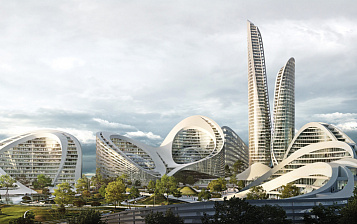“There are, however, places, looking at which on the map for a moment makes you related to Providence. There are places where history is inevitable, like a traffic accident, places whose geography brings history to life. Such is Istanbul, aka Constantinople, aka Byzantium.
Joseph Brodsky
Istanbul - the meeting point of East and West
Luxurious, stunning, charming, with a unique charm and attractiveness - this is not a complete list of epithets that Istanbul deserves, having managed to be the capital of four empires: Roman, Byzantine, Latin and Ottoman. Despite the fact that the modern capital of Turkey is the city of Ankara, Istanbul retains its special significance, but in a slightly different capacity, as the centuries-old center of world Orthodoxy and the place where the residence of the Archbishop of Constantinople - New Rome and the Ecumenical Patriarch is located. Istanbul is not the capital of Turkey , as for some reason many still think. Yes, this is one of the largest cities in Turkey and one cannot but agree that in terms of popularity, it is many times ahead of the capital Ankara. Today's Istanbul is not only the leading economic and cultural center of modern Turkey. According to the apt definition of one of the orientalists, this is a real pearl in the open air, which has no price. There are so many architectural sights in the city, and so many valuable artifacts are stored in museums that it can be argued that almost half of the historical and cultural heritage of the whole country is concentrated here. More than 6 million people - this is the annual official statistics of visiting Istanbul by travelers from different countries.
So why do millions of tourists visit Istanbul every year? Let's figure it out.
How to get to Istanbul
What is the best area to stay in Istanbul?
As you know, the city is divided by the Bosphorus into two parts: Asian and European.
It also has 39 districts, most of which are of no interest to the average tourist. Therefore, when choosing a district, you need to focus on proximity to the historical center so that you can get around the main sights on foot. The central district of Fatih includes the historical part of the city, which is called Sultanahmet.
It should be noted that this place is a UNESCO heritage and almost all the most important sights are concentrated here. Also, quite often, tourists choose the Besiktas area, which is not far from the center. If the purpose of the trip is outdoor recreation without the noisy Istanbul crowd, then the Princes Islands are an excellent option. There is no transport, except for bicycles, there is no noise, you can enjoy plenty of solitude with nature.
Topkapi Palace
This palace is the real heart of the Ottoman Empire, in which the most important events unfolded until the middle of the 19th century. For 400 years, the huge complex was the residence and office for 25 Turkish sultans. The palace was built on a hill on Cape Saraiburnu at the entrance to the Golden Horn Bay. This historical building covers an area of 700 thousand square meters and is surrounded by a wall, the length of which is 1400 meters. There is a mosque, and a school, and the Sultan's harem, and a place where guests of honor were received. At the moment, Topkapi is a museum where a lot of historical items are collected, ranging from books and weapons to national clothes. You can't visit Istanbul without visiting the Topkapi Palace. It is here that you feel the culture and greatness of the Ottoman people.
hagia sophia
As you know, the current Istanbul is the ancient city of Constantinople once conquered by the Ottomans. So Hagia Sophia was a huge Orthodox church built in Constantinople already in the 6th century. After the conquest, it ceased to function as a religious cathedral, and turned into a museum, a historical treasure. Nevertheless, the scale of the cathedral is impressive.
Hagia Sophia (Hagia Sophia) is one of the most visited attractions in Istanbul. It attracts tourists with its unique architecture, magnificent mosaics and special energy, so strong that it seems that you are immersed in a different reality, where different historical eras coexist at the same time. The Arabic script is adjacent here to the symbols of Christianity, and they, without mixing in any way, complement each other.
The monumental building of Hagia Sophia, located in the historical center of Istanbul, in the Sultanahmet district, is surrounded by four slender minarets, which makes it especially recognizable. Over the 1500 years of its existence, first the patriarchal Orthodox cathedral, then the mosque, and now the museum, which is an outstanding monument of Byzantine architecture, has retained its luxurious decoration, and this despite the fact that its extraordinary fate was rich not only in solemn, but also in tragic pages. .
Blue Mosque or Sultanahmet Mosque
The most famous and main mosque in Turkey is the blue mosque, built at the beginning of the 17th century by order of Sultan Ahmet I, after whom the mosque is now called. The massive temple with 5 main and 8 auxiliary round domes and 6 sharp needles of minarets got its name because of the internal lining with ceramic tiles with deep blue patterns. According to legend, the architect misunderstood the order of the Sultan, who wanted to make the domes golden, and eventually built several golden minarets, six blue ones. At that time, only one mosque in Mecca had six minarets in the world, which caused a scandal. Reshon, he was the one who added the seventh minaret in Mecca. The silver-gray complex on the banks of the Bosphorus, surrounded by gardens, simultaneously accommodates up to 10,000 believers. Tourists, subject to certain rules, are also allowed there at a strictly allotted time.
Dolmabahce Palace
Built in the 19th century by the decree of Sultan Abdulmecid I, who ordered to transfer his imperial court from Topkapi to a new luxurious palace on the banks of the Bosphorus. As a site for construction, he chose dolma bahçe ("mound garden") - the place where his predecessors, sultans Ahmet I and Osman II, erected a luxurious royal park. The building is absolutely not like the eastern palaces. More like European architecture. The queue in Dolmabahce is almost always impressive, but for a change, it is still recommended to visit the palace.
Grand Bazaar
To visit Istanbul and not go to the bazaar? Not allowed. The largest bazaar in Istanbul and one of the largest covered bazaars in the world is the Grand Bazaar. It is worth going there not only for shopping, but in order to feel the oriental culture.
Mehmet the Conqueror took possession of Constantinople in 1453, and the city ceased to be Christian. At the same time, the Sultan ordered the construction of a bazaar in order to develop trade. For centuries, the bazaar suffered from fires and even earthquakes, but the original plan of streets and houses with peaked roofs, connected by a whole labyrinth of narrow passages, is still preserved.
The Grand Bazaar is divided into separate areas selling specific goods, such as antiques, leather, jewelry, spices and carpets, but once in the middle of the bazaar, you feel like in a real labyrinth from where there is no way out. However, no matter how hot and crowded it may be, there is always a small cafe or counter nearby where you can drink a refreshing drink or relax by the fountains - they are arranged here at regular intervals. The Grand Bazaar is open from Monday to Saturday from 8.30 to 19.00.
Istiklal Street (Independence Street)
Istiklal Street is one of the most popular walking streets in Istanbul, located in Beyoglu district. The street originates at Taksim Square and goes towards the Golden Horn for about 1.4 kilometers. The street has the shape of a boomerang, at the bend point of which is the Galatasaray Square with the Galatasaray Lyceum.
The history of the street begins at the end of the 15th century, when the first Muslim settlements began to appear around the territory of modern Istiklal Street. At that time, the Galata tower already existed, and the gates from the city were located near the southern end of the modern street. Up to this time, forests grew in this area, located on the top of the hill. At the beginning of the next century, during the reign of Sultan Suleiman I, the territory of Istiklal began to be built up with Muslim buildings. This place also attracted Europeans, who also began to build their own houses, open workshops and shops. Gradually, the street, which at that time was called Cadde-i Kebir (Main Avenue), turned into a center of trade and crafts. In the 17th century, the street connected the area next to the Galata Tower and the living quarters of the Galata Palace. At the same time, embassies of various European countries begin to appear on the street. In the 18th century, the street began to extend to the north, along the way being built up with new churches (in 1724 the church of St. Anthony of Padua was built, in 1769 - the church of St. Mary), embassies and residential buildings.
From the second half of the 19th century, the street began to change its format, more adapting to European standards, while maintaining Asian features. In 1875, the second metro line in the world, Tunel, was opened with only two stations, which is still in operation. At the beginning of the 20th century, with the proclamation of the republic, the street was renamed to its current name, which means “Independence Street” in Turkish. The name was intended to commemorate the triumph of the Turkish War of Independence. At that time, Istiklal was a center of trade and recreation with many shops, cafes, restaurants, hotels.
In the 50s of the XX century, there was a massive outflow of the population from Istanbul, associated with reforms. In 1955, during the Istanbul pogroms, Istiklal was one of the main protest sites. After these events, the street fell into disrepair for a long time. Only in the 90s of the XX century, the renewal of Istiklal began - many new shops and restaurants were opened, and historical buildings were being restored.
Bosphorus
The Bosphorus Strait is an amazing geological phenomenon of our planet. This maritime artery, cutting through the 30-kilometer isthmus between Europe and Asia, connects two seas - the Black and Marmara, which are part of the Mediterranean basin. The average width of the Bosphorus is 2 km, and the minimum is 700 m, which makes the strait the narrowest on the planet.
The Bosphorus is located in Turkey. Its strategic, military and economic importance for the Black Sea and Mediterranean countries is obvious. The passage of merchant and warships through the Bosporus and Dardanelles is regulated by international maritime law and an international convention adopted in 1936. For passage through the strait, ship owners pay a lighthouse fee to maintain the operation of navigational signs, which guide captains. About 50 thousand large and small ships sail here every year.
The strait got its name in such ancient times. The myth tells that the Thunderer Zeus fell in love with the beautiful Io, and his wife Hera, having learned about this connection, vowed to take revenge. Then the loving god turned the girl into a cow, she swam across a narrow strait and hid in the mountains of Asia Minor. The word Bosporus means "Cow Ford".
It is interesting that in Ancient Greece two straits were called the Bosporus - the Thracian Bosporus (the Bosphorus itself) and the Cimmerian Bosporus (the Kerch Strait).
Only in 1973 the problem was solved, and the banks of the strait were connected by the first Bosphorus bridge. Its supports are installed on the shore, and the roadbed is suspended on cables. The second cable-stayed bridge was built in 1988.
In the north of the Bosphorus, at the exit to the Black Sea, in 2016, the bridge of Sultan Selim, almost one and a half kilometers long, was completed. It is open to rail and road traffic.
Galata bridge
There has always been a lively city center, no matter how it is called - ancient Byzantium, medieval Constantinople, Sultan's Istanbul. There are hundreds of moorings in the Golden Horn Bay, and each one sells freshly caught fish.
The shores of the bay are connected by four bridges, the most famous of them is Galata. Life is in full swing on this colorful bridge: cars go along the upper level in eternal traffic jams, fishermen stand with fishing rods along the fences, and the most unexpected goods of the “flea market” are immediately laid out. On the second tier, above the water, there are dozens of small restaurants and cafes offering delicious fish, shrimp and other seafood dishes. All the freshest, caught in the Bosphorus and the Sea of Marmara in the morning. Visitors can choose the fish themselves on the display case with ice, and it will be cooked right away. Dorada, herring, sea bass are caught on spinning rods here by restaurant fishermen. A good choice of such delicacies in the restaurant "Balik Noktasi". Yachts often sail up to it to take lunches ordered by phone for passengers. The waterfront is dotted with similar establishments. Often inexpensive cafes are arranged right on the moored fishing feluccas.
Taksim Square is a square in the central part of Istanbul (Taksim microdistrict, Beyoglu district).
The road of every guest of Istanbul will definitely lead him to the heart of the European half of the city - to Taksim Square. In this lively place where the borders of two worlds - modern and historical - collide, holidays and folk festivals are held. There are a number of prestigious hotels and many shops on this square. The square is a place of mass celebrations of both the local population and tourists. Taksim Square was built on the Armenian cemetery "Surb Hakob" (St. Hakob), which was once located here, founded in the 16th century during the reign of Sultan Suleiman I. During the ongoing construction on Taksim Square, 16 Armenian graves and the remains of the walls of buildings of the 19th century were discovered.
On May 1, 1977, during a May Day demonstration of many hundred thousand people, a planned execution took place, and then the violent dispersal of the people by the police. At the end of May 2013, the square became the site of a clash between the Turkish police and demonstrators who opposed the cutting down of trees in Taksim Gezi Park and the construction of a shopping center there .
In addition to the sights, you just need to stroll along the promenade by the Sea of Marmara, try fried mussels, just caught in the sea, be sure to drink fragrant tea from armud cups, or enjoy rich Turkish coffee. Walking around Istanbul, it is impossible to pass by local cafes. Turkish cuisine is very famous: dolma, lahmacun, kebabs, baklava, Turkish delight, pishmanye and much more.
Basilica Cistern
The Basilica Cistern is an amazing monument of ancient Byzantine architecture in the historical center of Istanbul. This huge underground structure stored water for the imperial Grand Palace.
The existence of this colossal underground structure is not known to all travelers who hastily visit Istanbul on their way to the Mediterranean Turkish resorts. Meanwhile, the Basilica Cistern is literally under the feet of tourists visiting Hagia Sophia, the Blue Mosque and other famous buildings in the historic center of the city.
Fortunately, the existence of a secret underground reservoir was not known to the Ottomans, who captured and ruthlessly destroyed the city of Constantine in 1453. It is very likely that the surviving defenders of Byzantium spent their last days here. Subsequently, the Cistern was discovered, and it supplied the palaces and gardens of the Turkish sultans with water, and then was abandoned and turned into a giant underground garbage dump. It wasn't until 1985 that the dungeon was cleared and turned into a tourist site. Today this monument of Byzantine architecture is under state protection. The Basilica Cistern is included in the list of outstanding buildings of the cultural heritage of the Greco-Roman civilization that developed in Constantinople.
Over the past fifteen hundred years, nothing has changed in the dungeon. The mighty brick walls of the reservoir, 4 meters thick, are impregnated with a layer of waterproof resin-based mixture. By the way, Byzantine waterproofing is reliable to this day, and the secret of a waterproof solution has not been revealed. Researchers believe that the builders hammered millions of chicken eggs into the lime mixture. The walls form a rectangular pool measuring 140 by 65 meters, outlining an area of 9800 m². Up to 100 million liters of water were placed here.
Curious travelers will be interested to see the endless rows of 336 columns with capitals, executed in various classical Greek and Roman styles, which indicate different eras of their creation. Several fluted Doric pillars were carved for unknown monuments erected several hundred years before our era.
In addition to the sights, you just need to stroll along the promenade by the Sea of Marmara, try fried mussels, just caught in the sea, be sure to drink fragrant tea from armud cups, or enjoy rich Turkish coffee. Walking around Istanbul, it is impossible to pass by local cafes. Turkish cuisine is very famous: dolma, lahmacun, kebabs, baklava, Turkish delight, pishmanye and much more.


 DOWNLOAD
DOWNLOAD LOOK
LOOK
 Top Content of the Month
Top Content of the Month


